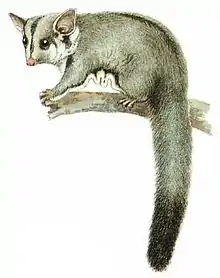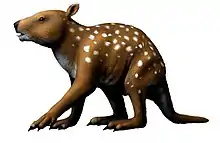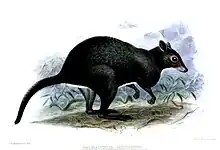| Dorcopsoides | |
|---|---|
| Scientific classification | |
| Domain: | Eukaryota |
| Kingdom: | Animalia |
| Phylum: | Chordata |
| Class: | Mammalia |
| Infraclass: | Marsupialia |
| Order: | Diprotodontia |
| Family: | Macropodidae |
| Genus: | †Dorcopsoides Woodburne, 1967 |
| Species: | †D. fossilis |
| Binomial name | |
| †Dorcopsoides fossilis Woodburne, 1967 | |
Dorcopsoides is a genus of extinct species of kangaroo from the Pliocene of Australia.[1]
Description
Dorcopsoides was described in 1967 from the well-preserved lower jaw, skull fragments and occipital found in the Upper Miocene Alcoota Fossil Beds north-east of Alice Springs in the Northern Territory. It was part of the Alcoota local fauna, which also included zygomaturine diprotodonts, a type of mihirung (Ilbandornis), a crocodile (Baru) and the giant thylacine, Thylacinus potens.[2]
It was about the size of a gray and black four-eyed opossum. The generic name (Dorcopsoides) indicates a resemblance to forest wallabies (Dorcopsis) now living in New Guinea and neighboring islands.[3]
References
- ↑ "Dorcopsoides". Fossilworks from the Paleobiology Database.
{{cite web}}: CS1 maint: postscript (link). - ↑ Alcoota Fossil Beds – Government of the Northern Territory
- ↑ Long, John A. & Archer, Michael (2002). Prehistoric mammals of Australia and New Guinea: one hundred million years of evolution. UNSW Press. p. 170. ISBN 978-0801872235.
{{cite book}}: CS1 maint: multiple names: authors list (link)
This article is issued from Wikipedia. The text is licensed under Creative Commons - Attribution - Sharealike. Additional terms may apply for the media files.



